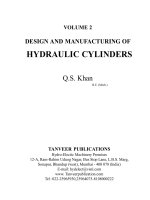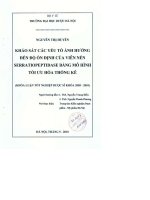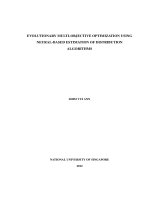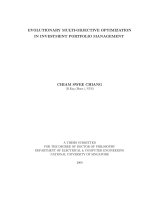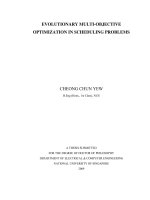MULTI OBJECTIVE OPTIMIZATION ON PRECISION DIE DESIGN OF HIGH PRESSURE DIE CASTING tối ưu hóa đa mục TIÊU TRONG THIẾT kế CHÍNH xác KHUÔN đúc áp lực CAO
Bạn đang xem bản rút gọn của tài liệu. Xem và tải ngay bản đầy đủ của tài liệu tại đây (763.09 KB, 10 trang )
Kỷ yếu hội nghị khoa học và công nghệ toàn quốc về cơ khí - Lần thứ IV
MULTI-OBJECTIVE OPTIMIZATION ON PRECISION DIE DESIGN OF
HIGH PRESSURE DIE CASTING
TỐI ƯU HÓA ĐA MỤC TIÊU TRONG THIẾT KẾ CHÍNH XÁC
KHUÔN ĐÚC ÁP LỰC CAO
Anh Tuan Doa, Tien Hung Dob
Hung Yen University of Technology and Education,
a
;
ABSTRACT
Precision high-pressure die casting (HPDC) for non-ferrous casting applications is
increasingly used in the foundries. For die design of HPDC, it needs well-design of gating,
runner system, die cavity. This paper focuses on the following issues: filling simulation,
defect analysis by computer aided simulation, finally the use of the Taguchi analysis to find
out optimal parameters and factors to increase the aluminum A380 die-casting quality and
efficiency. After analysis the results of optimum are: gate area of 40 mm2, group 2 location of
gate, gate velocity 50 m/s, liquid alloy temperature 640°C. Based on the results of calculation
parameters, we conducted design die by computer aided with the main objective is to optimize
the die design parameters. The use of this integrated solution can shorten the cycle of die
design and manufacture, and result in the production of high quality die castings in the
shortest time with the biggest profit.
Keywords: die design, Taguchi method, die-casting, shrinkage porosity, A380 aluminum.
TÓM TẮT
Độ chính xác đúc áp lực cao (HPDC) cho các ứng dụng đúc kim loại màu được sử dụng
trong các xưởng đúc. Đối với thiết kế khuôn đúc áp lực cao, cần thiết kế tốt cổng rót, hệ thống
rãnh, lòng khuôn. Bài báo này tập trung vào các vấn đề sau: mô phỏng điền đầy, phân tích lỗi
với hỗ trợ của máy tính, cuối cùng là sử dụng các phân tích Taguchi để tìm ra các thông số tối
ưu và các yếu tố để tăng chất lượng đúc và hiệu quả của hợp kim nhôm A380. Sau khi phân
tích các kết quả tối ưu là: khu vực cửa khẩu là 40 mm2, nhóm 2 vị trí của cửa khẩu, vận tốc
cổng 50 m/s, nhiệt độ hợp kim lỏng 640°C. Dựa trên kết quả của các thông số tính toán,
chúng tôi tiến hành thiết kế khuôn bằng hỗ trợ của máy tính với mục tiêu chính là để tối ưu
hóa các thông số thiết kế khuôn. Việc sử dụng các giải pháp tích hợp này có thể rút ngắn chu
trình thiết kế khuôn và sản xuất, và dẫn đến việc sản xuất các vật đúc khuôn chất lượng cao
trong thời gian ngắn nhất với lợi nhuận lớn nhất.
Từ khóa: thiết kế khuôn, phương pháp Taguchi, đúc áp lực, xốp co ngót, nhôm A380.
1. INTRODUCTION
High-pressure die casting (HPDC) process is significantly used in the industry for its
high productivity and less post-machining requirement. Due to light weight and good
forming-ability, aluminum die casting plays an important role in the production of
transportation and vehicle components. It has a much faster production rate in comparison to
other methods and it is an economical and efficient method for producing components with
low surface roughness and high dimensional accuracy. All major aluminum automotive
components can be processed with this technology. The development of industrial die-casting
and requirements for higher quality product, shorter development times and more complex
geometry, the use of computer aided simulation has become essential to stay competitive.
569
Kỷ yếu hội nghị khoa học và công nghệ toàn quốc về cơ khí - Lần thứ IV
The HPDC castings production process has many defects, such as: shrinkage porosity,
misrun, cold-shut, blister, scab, hot-tear. Several previous studies of defects in aluminum
alloy by the method of HPDC and disability solutions. Techniques such as cause-effect
diagrams, design of experiments (DOE), casting simulation, if-then rules (Fuzzy Logic
Controller), genetic algorithms (GA) and artificial neural networks (ANN) are used by various
researchers for analysis of casting defects. Dargusch et al [1] used pressure sensor in the
cavity to make a confident statement of aluminum that molten metal velocity increases and
porosity development with high pressure die- casting. Guilherme [2] used the design of
experiments (DOE) to find out the best parameters in production and notice that: porosity low
indices are related with low speeds from slow and fast shots and high upset pressures.
Mousavi Anijdan et al [3] used genetic algorithm (GA) methods to determine the optimum
conditions leading to minimum porosity in aluminum alloy die casting. Tsoukalas, V.D [4,5]
used the design of experiments (DOE) and genetic algorithm (GA) methods to determine the
optimum conditions leading to minimum porosity in aluminum alloy die castings. Syrcos, G.P
[6] used Taguchi method to determine the optimum conditions leading to casting density in
aluminum alloy die castings. S. Yue et al [7] used CAD/CAE/CAM simulation and analysis
with the purpose the quality of the die castings improved greatly in a shorter time. Prasad
K.D.V.Y et al [8] used the artificial neural network (ANN) methods to determine the optimum
conditions in aluminum alloy die castings. P.K. Seo et al [9] used CAD/CAE simulation and
analysis with purpose minimizing the porosities and hot-spots for applying in die casting.
However, most researchers were used to predict solidification and optimize aluminum alloy
casting process parameters in the condition of production foundry factory. Little was
published die design in die-casting, gating and die casting parameters. Approximately 90% of
defects in die casting components are due to die design errors (F. Shehata [10]). Die design is
a very difficult work and the company often does not publish because of economic
competition. In order to good die design it requires extensive knowledge in mechanical
engineering and experience in die-castings foundry factory.
In this paper, the ProCAST® Software commercial is used for analysis casting defects
and die filling simulation to enhance the quality and efficiency of die casting. The Taguchi
method control with design of experiments will be developed to improve aluminum die
casting quality and productivity in the cold chamber die casting method. After conducting a
series of initial experiments in a controlled environment, significant factors for die casting
processes are selected to find the optimal parameters to increase the aluminum die casting
quality and efficiency. Based on the results from analysis by considering the influence of
defects on quality castings, we conducted die design to die-casting with optimal parameters. It
is suggested to reduce casting defects, reduce time and money, increasing with better casting
product quality and die design die-casting efficiency.
2. MATERIAL AND METHODS
2.1. Basic design
Fig. 1. The model 3D of automobile
Die casting of this study is provided through aluminum die-casting factory, so the
casting body no changes. The 3D solid model of automobile start motor casing part is shown
in Fig. 1.
570
Kỷ yếu hội nghị khoa học và công nghệ toàn quốc về cơ khí - Lần thứ IV
The 3D drawings of objects cast to represent the color with different meanings.
Accordingly, the white light is the portion need to be machined or cut later. Depending on the
material molding, casting method and mechanical processing methods after casting product
finished that the designer will select the size, tolerances, metal machining appropriate for
requirements. The nature of the material will directly affect the quality of the casting and diecasting parameters configuration, this study selects casting material as the aluminum alloy
A380. The chemical composition of the aluminum alloy used in the experimental procedure is
given in Table 1.
Table 1. Chemical composition of the alloy A380 used
The die with a specific gating system will perform differently on different die-casting
machines. Only by considering both the die and machine characteristics could optimal flow
conditions be achieved. Therefore, P-Q2 technique is employed to predict the best gate area,
flow rate, filling time and gate velocity. This will avoid excessive calculation and ensure that
the gating system is designed properly. With the computer aided design software, we design
the simply filling system with die casting gate and runner; therefore, there is no overflows
port, gate and runner design based on the P-Q2 diagram and Bernoulliz flow according
Bernoulli equation [11]. In this basic study, we mainly focused on the choice of the in-gate
area, location of gate and velocity of molten alloy A380 at the gate.
From the 3D solid of a part is supplied and ordered from casting factory, we design the
3D of the die casting including the information of machining allowance, shrinkage and
casting tolerances by using the CATIA® V5R19 software. Our designs include 3 locations of
gates with the basic shapes as Fig. 2.
Fig. 2. The location of gate
The in-gate area calculation formula is as shown in formula (1):
Ag =
where:
G
ρ .vg .T
(1)
T: pouring time, Sec; G: casting weight, g;
Ag: Cross-sectional area of the gate, mm2.
We can also use following formula (2) to calculation Ag as:
571
Kỷ yếu hội nghị khoa học và công nghệ toàn quốc về cơ khí - Lần thứ IV
Ag2 =
Q2
p.2.g
Cd2 .
(2)
ρ
where:
p: metal pressure, kg/mm2
ρ: metal density, g/cm3, A380 as 2.580 g/cm3
g: Gravity (9.81 m/Sec2)
Q: liquid metal flow, mm3/Sec.
v: gate velocity, m/Sec
C d : Eject factor, aluminum is 0.5 ∼ 0.6, 0.5 used in this paper
In addition, cross-sectional area of the gate for the use of formula (1) or the ProCAST®
Software commercial built in the PreCAST module to calculate for speed of molten alloy. At
that filling time, there is a period of liquid metal flows from the gate until the entire die
cavity. Based on data provided by the NADCA (North American Die Casting Association)
formed by the die casting thickness of about 3.2mm, filling time between 0.42 to 0.71 seconds
[11], and with the formula (1) on the design criteria for the location of the gate [12] to find the
appropriate location of the gate, together with the calculated step to complete the gate system.
Analysis software is used as a ProCAST® commercial with finite element method
(FEM) analysis for a casting process. In this paper, all parameters can be able to affect the
analysis process, choice of material is aluminum alloy die casting A380, cold chamber die
casting method with the die material is H13. FEM based simulation software systems help the
designer to visualize the metal flow in the die cavity, the temperature variation, the
solidification progress, and the evolution of defects such as shrinkage porosity, cold-shut, hottear. Z. Sun et al [13] used Taguchi analysis and CAE technique to predict the filling velocity
and shrinkage porosity numerically, based on the results receiving the author performed
optimal parameters for the gating system. D.R. Gunasegaram et al [14] used the design of
experiments (DOE) determined that a thicker mold coat and a higher mold temperature would
modify temperature profiles in the casting. Q.C. Hsu et al [15] used Taguchi analysis and
CAE technique to study the shrinkage porosity formation in HPDC, the authors have found
these factors affect the molding process and improve quality aluminum die casting and
productivity in the cold chamber die casting method. This paper focused on analysis of
shrinkage porosity defect, the percentage fill rate to determine the experiment.
2.2. Experiment and analysis
Taguchi method is one of the solving tools to upgrade the performance of products and
processes with a significant reduction in cost and time involved. The Taguchi′s parameter
design offers a systematic approach for optimization of various parameters with regard to
performance, quality and cost (Tsoukalas, V.D [4,5], Syrcos, G.P [6]).
Shrinkage porosity formation in pressure die casting is the result of a so much number
of parameters. Fig. 5 shows a cause and effect diagram that was constructed to identify the
casting process parameters that may affect die casting porosity. In this case, holding furnace
temperature (Liquid alloy temperature), speed of molten alloys of the gate (Gate velocity),
cross section of the gate (Gate area) and location of the gate (Gate location) were selected as
the most critical in the experimental design. The other parameters were kept constant in the
entire experimentation. Gate velocity has an influence on mechanical properties of the
casting and on the properties in the casting surface quality. High gate velocity produces
higher mechanical properties and less porosity than lower gate velocity. New High Pressure
Die Casting machines are capable of producing gate velocity up to 100 m/s, but the die
erosion started to increase already around 60 m/s. For that reason the higher gate velocity
572
Kỷ yếu hội nghị khoa học và công nghệ toàn quốc về cơ khí - Lần thứ IV
range from 60 m/s to 100 m/s is not very practical (F. Shehata [10], ZHANG Weishan et al
[16]). Based on technical parameters of high pressure die casting machine SD-500CF from
LIKW Enterprise Corp-Taiwan, we select the velocity of the liquid alloy in range: 30∼50
m/s. Shrinkage porosity can be reduced without raising the gate velocity by designing the
gate and runner system to maintain smooth, continuous flow profiles and by designing the
casting so that no backflow occurs. This paper used cast material is A380 with the melting
temperature is range (540∼595) °C, experiential from foundry factory range (540∼595) +
(100∼120) °C is superheated the need to use. Solution temperature range (640∼720) °C are
selected in this paper. The selected casting process parameters are calculated by formula (1),
(2) and Bernoulliz flow given in Table 2.
Fig. 3. Fish-bone diagram
Fish-bone diagram [2], [4], [5], [6], [7], [17] of the configuration shown in Fig. 3, in
which the head is shrinkage porosity die casting defect, and the objective to be taken
“smaller-the-better”.
According to cause and effect diagram of the factor level table, as shown in Table 2, on
behalf of the L 9 orthogonal array as Table 3.
Table 2. Factor level table
Table 3. Experimental layout using an L 9
orthogonal array
For the amount of inspection shrinkage casting part used for the ViewCAST module
function for quantitative analysis. The parameters are taken from Table 3 and conduct nine
experiments. In each experiment we took five elements with the coordinates determined at the
important positions in the working conditions of automobile starter motor casing. Each
experiment was repeated five times sampling in order to reduce experimental errors, as shown
in Fig. 4. Data from nine experiments with five sampling times in each simulation are
summarized as in Table 4. From this table we conducted quality characteristics analysis.
573
Kỷ yếu hội nghị khoa học và công nghệ toàn quốc về cơ khí - Lần thứ IV
Table 4. The experimental data.
Fig. 4. Castings measurement
Shrinkage porosity area
The parameter design study involves control and noise factors. Measure of interactions
between these factors with regard to robustness is signal - to - noise (S/N) ratio. S/N
characteristics formulated for three different categories are as follows: the bigger the better,
the smaller the better, the nominal the best. This paper focused on studying the effects of four
input parameters (A, B, C, D) to defect shrinkage porosity in the process of casting, so the
criteria "the smaller the better" is selected.
The smaller the better (for making the system response as small as possible):
1 n
S / N S = −10 log ∑ yi2
n i =1
(3)
where:
n: number of sampling, n=5 (each experiment was repeated five times sampling);
yi : value of shrinkage porosity at each time sampling.
Analog measurement data, calculated by formula (3) after sorting out the S/N response
table as Table 5 and S/N response graphs in Fig. 5, by the responding graph learned that the
best combination in this study for aluminum die casting shrinkage defects: A 3 B 2 C 1 D 3 .
Table 5. S/N response table
-3.600000
-3.700000
A1A2A3
B1 B2 B3
C1 C2 C3
D1D2D3
-3.800000
A
-3.900000
-4.000000
-4.100000
B
C
D
Average
-4.200000
-4.300000
-4.400000
Fig. 5. S / N Response graphs
Analysis of variance (ANOVA): Through the contribution rate calculated results shown
in Table 5.6, and the contribution of each factor is organized in the chart, as shown in Fig. 6.
574
Kỷ yếu hội nghị khoa học và công nghệ toàn quốc về cơ khí - Lần thứ IV
Table 5.6 The ANOVA table
Fig. 6. Contribution rate histogram
In this study, the results of the optimum parameters via Taguchi design are: the gate
area of 40 mm2, group 2 of the gate location, the speed of the liquid metal at the gate is 50
m/s, the temperature of molten aluminum 640°C. The casting process simulation by ProCAST
can determine the location of shrinkage formed by the temperature field and the solid fraction,
and it is also to understand the reasons for the formation of defects. Therefore, it can help in
further design priority to avoid shrinkage porosity defect.
2.3. Computer aided die design
High pressure die casting (HPDC) with the gating system consists of a biscuit or a
sprue, runners system, a gate, overflows and vents. There are two basic gate types: tangential
and fan-gate (Gating manual, NADCA, USA. 2006. p.56 [18], S.H. Wu et al [19], B.H. Hu et
al [20]). Both gates are usually designed with converging cross sectional area. The selection
between the gate types depends on the part requirements. Fan-gate is the simplest in structure
and easier to machine. Tangential gates are more difficult to design and machine, but the
design is flexible and easy to adapt to different technical requirements. The designer should
ensure that the gate and runner system to maintain smooth, continuous flow profiles and by
designing the casting so that no backflow occurs or two lines overlap. Based on the technical
side-core and molding direction we design two types of gate systems with components of a
biscuit (diameter: 70 mm), a runner, a gate, overflows. Two types runner is designed as Fig. 7
and Fig. 8 with a cross section of gate: 40 mm2
Fig. 8. Die-casting with half inlet.
Fig. 7. Die-casting with full inlet.
The results of the optimum parameters via Taguchi Design will be installed in ProCAST
software with parameters for two cases (full inlet and half inlet):
- gate area of 40mm2
- gate location: group 2
- speed of the liquid metal of the gate is: 50 m/s
- the temperature of molten aluminum: 640° C
- the temperature of die: 180° C
- water cooled
With full inlet filling of the liquid metal flow in the die cavity is good. In case of half
inlet, not fill in all the volume of die cavity, high pressure increased. The shortage metal
575
Kỷ yếu hội nghị khoa học và công nghệ toàn quốc về cơ khí - Lần thứ IV
occurs as Fig. 10 mean that having a disability and the option half inlet design cannot be used
for further study.
Fig. 9. Shortage of the casting with half
inlet
Fig. 10. Shrinkage porosity of the casting
with full inlet
Shrinkage porosity analysis as in Fig. 10 with full inlet case shows that need additional
overflows in some locations important to reduce this phenomenon shrinkage porosity. Fig. 11
shows solid 3D of dies with full gating system.
Fig. 11. 3D solid model of die casting dies
Fig. 12. Shrinkage porosity of castings
The simulation results with the parameters setting on the ProCAST are calculated in the
previous steps. The result of test is the liquid metal fill in full of die cavity. Fig.12 show that
the casting no defects and shrinkage porosity acceptable.
3. RESULTS AND DISCUSSION
The die for this study is the result of collaboration between the LIKW Enterprise Corp,
Taiwan and Department of Mechanical Engineering - Hung Yen University of Technology
and Education.
The entire die will be installed on the SD-500 CF casting machine as Fig. 13 with the
parameters setting on the machine are calculated in the previous steps.
Fig. 14. The product after casting
Fig. 13. Casting in SD-500CF die-casting machine
576
Kỷ yếu hội nghị khoa học và công nghệ toàn quốc về cơ khí - Lần thứ IV
The product after casting to the naked eye without disabilities, show in Fig. 14.
Fig. 15. X-ray film testing of samples casting
Tested X-ray by ERESCO 160 MF4-R machine for samples casting with parameters:
2% sensitivity, 30 Sec time exposure in the critical sections of castings. Results showed no
defects shrinkage porosity and no cracks inside, good quality castings, as shown in Fig. 15.
The results between simulation and experiment indicate that the liquid metal in the mold
filling full, no cracks inside, shrinkage porosity acceptable. That means the die are designed
and manufactured optimization in accordance with the conditions of the foundry factory
production.
CONCLUSIONS
The experiments, that are conducted to determine the best levels, are based on
"Orthogonal Arrays", are balanced with respect to all control factors and minimum in number.
One method of casting defect analysis is proposed and studied which is a combination
of design experiments by Taguchi method and Computer aided casting simulation technique
for analysis of the optimal die design.
The results of the optimum parameters via Taguchi design for the gate area of 40 mm2,
group 2 of the gate location, the speed of the liquid metal at the gate is 50 m/s, the
temperature of molten aluminum 640° C.
For analysis of defect such as shrinkage porosity computer aided casting simulation
technique is the most efficient and accurate method. The quality of the casting product can be
efficiently improved by computer assisted casting simulation technique in the shortest
possible time and without the conventional trial and error on foundry factory. This in turn
implies that the resources (materials, saving time and money) required for the experiments are
also minimized. It saves very much helpful and a great effort and money.
REFERENCES
[1]. Dargusch, M.S., Dour, G., Schauer, N., Dinnis, C.M. & Savage, G, The influence of
pressure during solidification of high pressure die cast aluminum telecommunications
components, Journal of Materials Processing Technology, 2006, Vol. 180, p. 37∼43.
[2]. G.O. Verran, Influence of injection parameters on defects formation in die casting
Al12Si1.3Cu alloy: Experimental results and numeric simulation. Journal of Materials
Processing Technology, 2006, Vol. 179, p. 190∼195.
577
Kỷ yếu hội nghị khoa học và công nghệ toàn quốc về cơ khí - Lần thứ IV
[3]. Mousavi Anijdan, S.H., Bahrami, A., Madaah Hoseini, H.R. & Shafyei, A, Using
genetic algorithm and artificial neural network analyses to design an Al–Si casting alloy
of minimum porosity. Materials and Design, 2006, Vol. 27, p. 605∼609.
[4]. Tsoukalas, V.D, A study of porosity formation in pressure die casting using the Taguchi
approach. Journal of Engineering Manufacture, 2004, Vol. 218, p. 77∼86.
[5]. Tsoukalas, V.D, Optimization of porosity formation in AlSi9Cu3 pressure die castings
using genetic algorithm analysis. Materials and Design, 2008, Vol. 29, p. 2027∼2033.
[6]. Syrcos, G.P, Die casting process optimization using Taguchi methods. Journal of
Materials Processing Technology, 2003, Vol. 135, p. 68∼74.
[7]. S. Yue, G. Wang, F. Yin, Y. Wang, J. Yang, Application of an integrated
CAD/CAE/CAM system for die casting dies. Journal of Materials Processing
Technology, 2003, Vol. 139, p. 465∼468.
[8]. Prasad K.D.V. Yarlagadda, Eric Cheng Wei Chiang, A neural network system for the
prediction of process parameters in pressure die casting. Journal of Materials
Processing Technology, 1999, Vol. 89-90, p. 583∼590.
[9]. P.K. Seo, H.C. Kim, C.G. Kang, Numerical integration design process to development
of suspension parts by semi-solid die casting process. Journal of Materials Processing
Technology, 2007, Vol. 183, p. 18∼32.
[10]. Farouk Shehata, Mohamed Abd-Elhamid, Computer aided foundry die-design.
Materials and Design, 2003, Vol. 24, p. 577∼583.
[11]. Die casting Handbook, 2th edition, NADCA, 2001.
[12]. Handbook Volume 15: Casting, ASM International Handbook Committee, 2008, p.
715∼718 and p. 724∼726.
[13]. Z. Sun, H. Hu, X. Chen, Numerical optimization of gating system parameters for a
magnesium alloy casting with multiple performance characteristics. Journal of
Materials Processing Technology, 2008, Vol. 199, p. 256∼264.
[14]. D.R. Gunasegaram, D.J. Farnsworth, T.T. Nguyen, Identification of critical factors
affecting shrinkage porosity in permanent mold casting using numerical simulations
based on design of experiments. Journal of Materials Processing Technology, 2009,
Vol. 209, p. 1209∼1219.
[15]. Q.C. Hsu, A.T. Do, K.C. Yeh, J.H. Ye, Improvement on die-casting efficiency and
property of aluminum alloy casing. Key Engineering Materials, 2015, Vol. 625, p.
518∼524.
[16]. ZHANG Weishan, XIONG Shoumei, LIU Baicheng, Study on a CAD/CAE System of
Die Casting. Journal of Materials Processing Technology, 1997, Vol. 63, p. 707∼711.
[17]. G.O. Verran, R.P.K. Mendes, L.V.O. Dalla Valentina, DOE applied to optimization of
aluminum alloy die castings. Journal of Materials Processing Technology, 2008, Vol.
200, p. 120∼125.
[18]. Gating Manual, NADCA, USA, 2006, p. 56.
[19]. S.H. Wu, J.Y.H.Fuh, K.S. Lee, Semi-automated parametric design of gating systems for
die-casting die. Computers & Industrial Engineering, 2007, Vol. 53, p. 222∼232.
[20]. B.H. Hu, K.K. Tong, X.P. Niu, I. Pinwill, Design and optimization of runner and gating
systems for the die casting of thin-walled magnesium telecommunication parts through
numerical simulation. Journal of Materials Processing Technology, 2000, Vol. 105, p.
128∼113.
578




